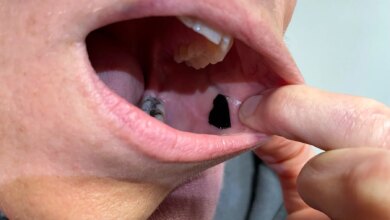How Neuromyelitis Optica Progressed for Me

Joanna Robles, MD, first began having unusual symptoms in the summer of 2020. She had bouts of nausea and vomiting that she couldn’t explain. Eventually doctors diagnosed her with neuromyelitis optica (NMO), but the initial days were confusing.
“I would have random episodes of retching, vomiting, and hiccups,” says Robles, a 32-year-old pediatric hematologist oncologist from North Carolina. “I felt exhausted and just wanted an answer for why I felt so terrible.”
First, she went to urgent care, then her primary care doctor, then a gastroenterologist to try to find out what was triggering her symptoms. The visits were all within a few weeks of each other because her nausea and vomiting had become so bad that she lost about 18 pounds in a very short time.
Right before Robles had an abdominal ultrasound and an upper endoscopy, she developed a new symptom. She started having vision changes. So she saw a neurologist after the tests.
“The neurologist ordered an urgent brain MRI, which was initially read as normal. My vision loss progressed to the point that I was essentially blind in my left eye in just a few days,” Robles recalls.
She was able to get an urgent appointment with an optometrist, who then referred her to outpatient neuro-ophthalmology. Robles reached out to the neurologist who had evaluated her a few days prior. It was discovered she had optic neuritis, a condition where the optic nerve in the eye is inflamed.
The neurologist sent her to the emergency room.
“The neuro-ophthalmologist that saw me in the emergency room immediately suspected that I had NMO because of how severe and how quickly my optic neuritis progressed and because of the nausea and vomiting that I had been experiencing before this,” she says.
A blood test during her hospitalization confirmed her diagnosis.
NMO, also known as Devic’s disease, is a rare disease that affects your eyes and spinal cord.
Most people who are diagnosed with NMO have either vision loss and eye pain — usually in one eye, but it can be both — or problems caused by inflammation of the spinal cord. That can include arm or leg weakness, numbness, and pain.
Uncontrollable nausea, vomiting, or hiccups like Robles had are less common symptoms but very specific to this disease, says Aaron Miller, MD, medical director of the Corinne Goldsmith Dickinson Center for Multiple Sclerosis.
The primary way to diagnose the disease is with a blood test that looks for antibodies against a protein called aquaporin-4 (also called NMO-IgG). When the disease has been diagnosed, doctors treat any flare-ups and then try to prevent other flare-ups from happening.
Robles was treated for her optic neuritis with IV steroids for 3 days in the hospital. Then she started taking oral steroids for a few weeks. Once her diagnosis was confirmed and she saw a neuroimmunologist, she started taking a drug called rituximab, which she now gets via IV every 6 months.
Several new drugs are FDA-approved for NMO. But because they are often not covered by insurance, many doctors start with older medications.
Robles found that her vision returned mostly back to normal a few weeks after starting the steroids. Sometimes she still has some issues.
“I notice some very minimal vision differences between the affected left eye and the right eye, but these seem to be a little worse for a bit if I am really tired or hot,” she says.
She only has nausea once in a while, and it seems to get triggered, she says, if she is very tired. Robles is easily able to manage it with nausea medicine but rarely needs to take it.
Probably her biggest symptom now is fatigue.
“This was something that my neurologist had warned me about, but I did not fully appreciate how debilitating this feeling could be until I experienced it myself,” she says. “I finally ended up starting a medication to help with my fatigue, which improved my symptoms significantly.”
People with NMO can control their symptoms and live for many years. But it’s very important to be treated as quickly as possible, says Miller.
“It’s an unpredictable disease, and it can be a very serious disease because this is a disease where people get neurological disability because of these flare-ups,” says Miller. “So if you have a bad flare-up and don’t recover well, you can end up with significant neurological disability.”
People who don’t control their symptoms and flare-ups could end up with blindness, arm or leg paralysis, depression, and loss of bowel or bladder control.
Miller says he has had a number of patients in his practice who have had NMO for several years and they’re doing very well with few or, in some cases, no symptoms.
Robles says her neurologist has been very encouraging about what to expect.
“I was told that most patients do not progress between relapses, and that the most important thing to prevent relapses is to be on a preventative,” she says. “I was warned about pseudo-flares where the symptoms from my old lesions could flare up, but I was warned that these should not persist and instructed to call immediately for new symptoms lasting more than 24 hours.”
Besides medical treatments, Robles says her faith, her husband, and her family and friends have been a key part to helping her live with her disease.
“I also really wanted to meet other people with the disease and understand what their lives looked like. I read the information about NMO but I did not know how this would change my life, so I joined a virtual group through The Sumaira Foundation, which has helped me cope over this past year,” she says.
“I am also slowly getting back to exercising regularly, which is something I had stopped doing when I started feeling sick.”
Source link




